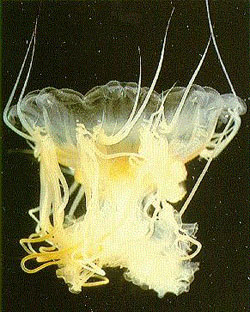



Scyphozoa: Life History and Ecology
 |
While many species live solitary lives, some like Aurelia may travel in shoals of hundreds to thousands of individuals stretching for dozens of kilometers. These mass accumulations can cause fishing problems, clogging nets and making them difficult to clean. At times, large shoals are washed ashore by storms; these beached jellyfish make the shore unsafe for humans, and their decomposition doesn't smell great either.
Food and waste must be passed in and out through the same opening, since like other cnidarians, they have no digestive tract. Cilia within the digestive cavity move water and dissolved food and gases around. While smaller jellyfish may feed on trapped food particles from the water, the larger jellyfish are predators on fish or on swimming invertebrates. They accomplish this by using special stinging cells to immobilize their prey.
The stinging cells of jellyfish, or cnidocysts, are located on the oral arms, and not the peripheral tentacles. While many jellyfish have not effect on humans, some stinging jellyfish may injure swimmers — causing fever and cramping, or even death. Even the broken tentacles or the bodies of beached jellyfish can be dangerous. Some juvenile fish, which are immune to the stings, travel with the jellyfish for easy food or for protection.
 The jellyfish Cassiopeia. Photo © 1993 Smithsonian Institution. |
Jellyfish reproductive biology is not well studied. The best studied genus is Aurelia, and that information will be presented here. There are separate sexes, male and female, though these are not easily distinguished by sight. Reproduction begins when the male releases sperm through its mouth into the surrounding water. These swim to the female where they enter her central oral cavity to reach the eggs. Once fertilized, the zygotes emerge onto the oral arms to develop for a time, becoming larvae which settle on the bottom of the ocean. The resulting polyp begins to bud asexually, releasing free-swimming medusae which go on to develop into adults. Some other scyphozoans live solely as polyps or as medusae, and do not alternate between these two phases the way that Aurelia does.
